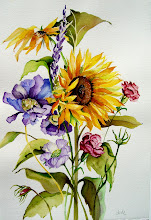
Today I've started blogging! Check out my website for available paintings and prints at
www.judewiesenfeld.com.
Here you will see my paintings in progress, my art tips and whatever seems interesting to me...artwise.
Please leave me your comments and questions. Let's make this a blog that you find helpful and fun.
So many beginners in art think of it as incredibly relaxing. I can get lost in my painting, but getting "into" it is never easy. Drawing correctly is a top priority. The best way to approach a painting is to take time deciding what to paint (like a good marriage, you want to develop the painting carefully). Lots of small correct decisions will carry you forward with the "development" of the work. Be patient! Most paintings don't look like much until very near the end when the darks and lights and "tweeking" takes place. Anyone can learn. Half the success is in the interest you have in the activity itself.
Today I would like to recommend to you two art books:
"Keys to Drawing" by Bert Dodson (the best book on the subject that I have found in the twelve years that I have been teaching)
"Painting Wildlife in Watercolor" by Peggy Macnamara and Marlene Hill Donnelly (beautifully illustrated paintings and detailed information on the process of painting animals)
The three colors you can mix to make a rich black are:
Crimson Alizarin
Sap Green
Ultramarine Blue
I prefer to not use black out of the tube, as it can create a hole in your painting...not literally (of course), but the area covered with the black will seem to be lost, ugly, not a part of the painting. If the black you mix is for trees, you can mix it with a little more green. If the area is a dark shadow from a blue vase, it can lean towards the bluer side of the scale, etc. Here is a painting of mine with a lot of black in it that is rich with red/green and blue color.
















 This is what I've been up to for the last few weeks. We found a tortoise behind our garbage cans in late April shortly after our dog, Zena, died. I posted a neighborhood sign and he was picked up by a family that said he'd been missing for four months from their home more than 10 miles away from our house. Imagine what an adventure he'd been on.
This is what I've been up to for the last few weeks. We found a tortoise behind our garbage cans in late April shortly after our dog, Zena, died. I posted a neighborhood sign and he was picked up by a family that said he'd been missing for four months from their home more than 10 miles away from our house. Imagine what an adventure he'd been on.
